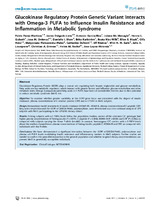Glucokinase Regulatory Protein Genetic Variant Interacts with Omega-3 PUFA to Influence Insulin Resistance and Inflammation in Metabolic Syndrome

Ver/
Autor
García-Ríos, Antonio
Mc Monagle, Jolene
Gulseth, Hanne L.
Ordovás, José María
Shaw, Danielle I.
Karlström, Brita
Kiec-Wilk, Beata
Blaak, Ellen E.
Helal, Olfa
Malczewska-Malec, Malgorzata
Defoort, Catherine
Risérus, Ulf
Saris, Wim H.M.
Lovegrove, Julie A.
Drevon, Christian A.
Pérez-Martínez, Pablo
Delgado-Lista, Javier
Roche, Helen M.
López-Miranda, José
Editor
Public Library Of Science (PLOS)Fecha
2011Materia
GCKROmega-3
Metabolyc syndrome
METS:
Mostrar el registro METSPREMIS:
Mostrar el registro PREMISMetadatos
Mostrar el registro completo del ítemResumen
Glucokinase Regulatory Protein (GCKR) plays a central role regulating both hepatic triglyceride and glucose metabolism.
Fatty acids are key metabolic regulators, which interact with genetic factors and influence glucose metabolism and other
metabolic traits. Omega-3 polyunsaturated fatty acids (n-3 PUFA) have been of considerable interest, due to their potential
to reduce metabolic syndrome (MetS) risk.
Objective: To examine whether genetic variability at the GCKR gene locus was associated with the degree of insulin
resistance, plasma concentrations of C-reactive protein (CRP) and n-3 PUFA in MetS subjects.
Design: Homeostasis model assessment of insulin resistance (HOMA-IR), HOMA-B, plasma concentrations of C-peptide, CRP,
fatty acid composition and the GCKR rs1260326-P446L polymorphism, were determined in a cross-sectional analysis of 379
subjects with MetS participating in the LIPGENE dietary cohort.
Results: Among subjects with n-3 PUFA levels below the population median, carriers of the common C/C genotype had
higher plasma concentrations of fasting insulin (P = 0.019), C-peptide (P = 0.004), HOMA-IR (P = 0.008) and CRP (P = 0.032) as
compared with subjects carrying the minor T-allele (Leu446). In contrast, homozygous C/C carriers with n-3 PUFA levels
above the median showed lower plasma concentrations of fasting insulin, peptide C, HOMA-IR and CRP, as compared with
individuals with the T-allele.
Conclusions: We have demonstrated a significant interaction between the GCKR rs1260326-P446L polymorphism and
plasma n-3 PUFA levels modulating insulin resistance and inflammatory markers in MetS subjects. Further studies are
needed to confirm this gene-diet interaction in the general population and whether targeted dietary recommendations can
prevent MetS in genetically susceptible individuals
